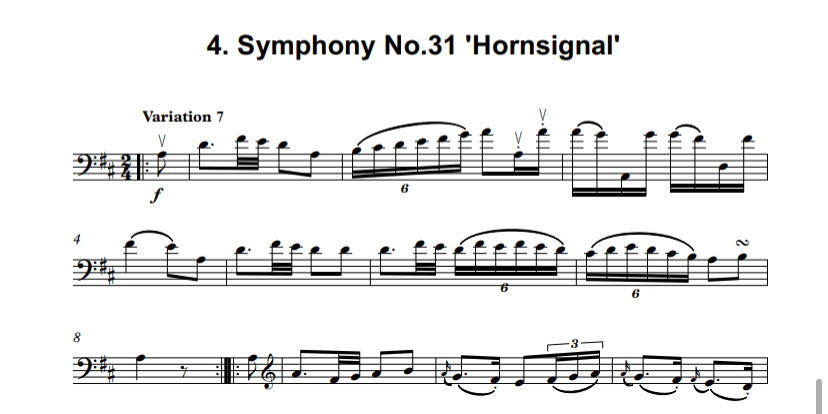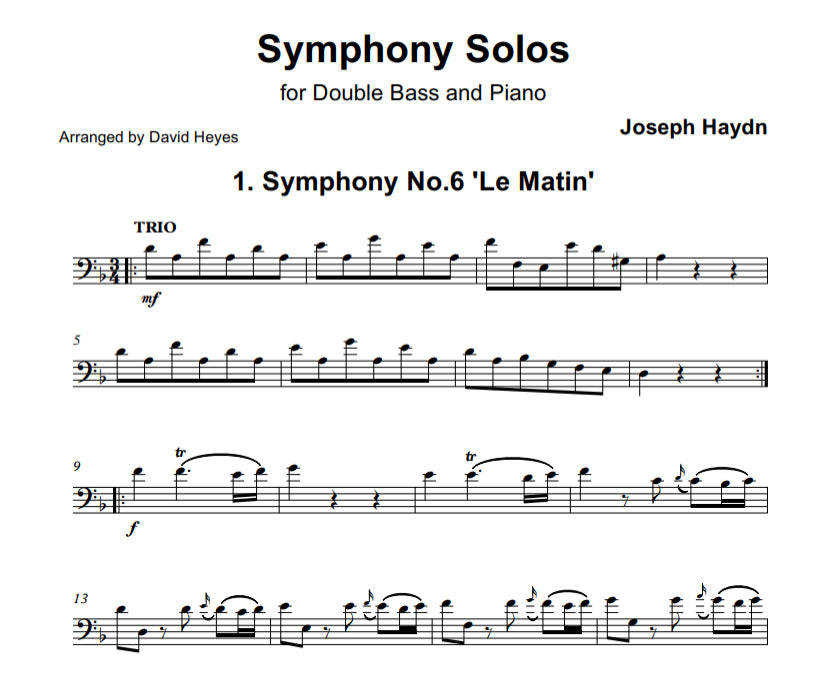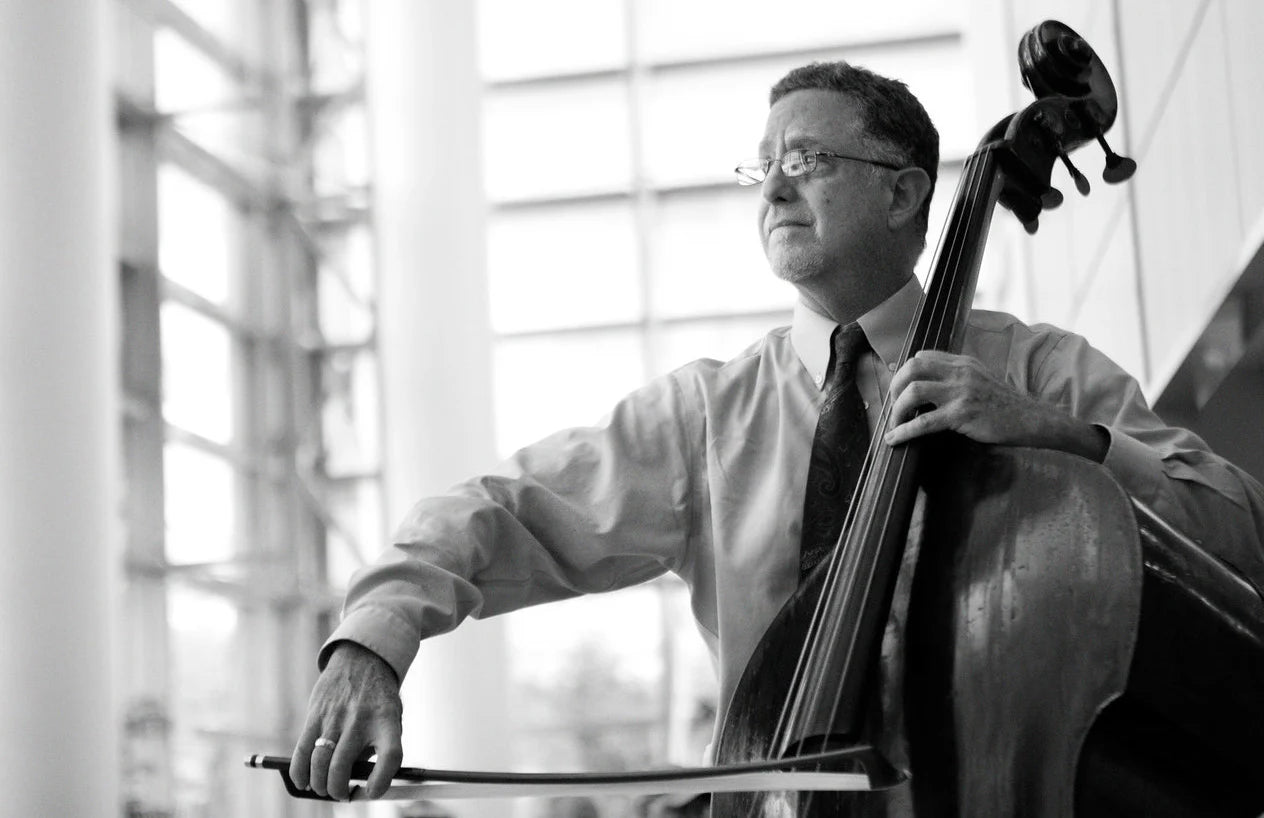David Heyes
Joseph Haydn: Symphony Solos for double bass & piano (arr. Heyes)
Joseph Haydn: Symphony Solos for double bass & piano (arr. Heyes)
Couldn't load pickup availability
About the Collection
Symphony Solos brings together six double bass solos from Haydn’s Symphonies. Primarily in bass clef and aimed at the intermediate bassist, these short solos are ideal for study or concert use and introduce bassists to popular solos from the classical orchestral repertoire.
The double bass, or more accurately the violone, was used as a soloist on a number of occasions in symphonies by Haydn. Nowadays usually played on a modern double bass tuned in fourths (GDAE), it is likely they were originally written for an instrument employing ‘Viennese tuning’ (AF#DAF) which was popular in and around Vienna from the early 1760s to the death of J.M. Sperger in 1812. Haydn’s ‘lost’ Double Bass Concerto in D major (1763) is one of the earliest works to use this tuning, alongside solo works by Dittersdorf, Vanhal, Hoffmeister, Pichl, Koželuch, Sperger, Kohaut, Zimmerman and Mozart.
Table of Contents
Joseph Haydn (1732-1809) composed 106 symphonies and 104 have numbers that were originally assigned by Eusebius Mandyczewski in 1908, based on the information available at the time. In recent years a number of chronological inaccuracies have been discovered, but the Mandyczewski numbers were so widely used that when Anthony van Hoboken incorporated these numbers into this own catalog. Over the years two additional symphonies have been discovered, named A and B, bringing the total number to 106.
Symphony No.6 in D major ‘Le Matin’Composed around 1761 and written soon after Haydn joined the Esterházy court, it is the first of three symphonies that feature extensive solo passages for different instruments in the orchestra. The title ‘Le Matin’ was not Haydn’s own but derives from the opening slow movement which appears to depict a sunrise. The Trio begins with solo passages for double bass and bassoon, later joined by viola and cello.
Symphony No.7 in C major ‘Le midi’This symphony includes solo passages for a number of instruments, including the double bass, and was probably composed in 1761. Featured at the beginning of the Trio in the third movement, lyrical phrases alternate with rhythmic arpeggio figures offering a range of challenges for the bassist.
Symphony No.8 in G major ‘Le soir’
Symphony No.8 continues the theme of soloists and orchestra and was also composed in 1761. The double bass solo begins the Trio section of the third movement and uses a number of upwardly moving scale figures to contrast a more lyrical and elegant 18th-century dance-like theme.
Symphony No.31 in D major ‘Hornsignal’
Composed in 1765 the name stems from the prominent role given to the unusually large horn section of four players. The size of Haydn’s orchestra fluctuated greatly, hence the different orchestrations he used during his years with the Esterházy family, and it is believed that this symphony was composed to celebrate that in 1765 two new horns players were engaged. The Finale comprises a theme and seven variations and the bassist plays the seventh and final variation, which favors ‘Viennese tuning’ but is also easily accessible for a double bass tuned in fourths. The bright and tuneful variation demonstrates the lyrical and technical skills of the bassist.
Symphony No.45 in F sharp minor ‘Farewell’
Composed in 1772 and written when Haydn and the court orchestra were at the summer palace in Esterháza. Their stay had been longer than usual and Haydn subtly hints that the prince might like to allow the musicians to return home when, during the final Adagio, each musician stops playing, snuffs out the candle, and leaves until there are only two muted violinists left. The prince allowed the musicians to return home the following day. The double bass solo is during the Adagio of the fourth movement and the symphony is in F sharp minor, an unusual key for the period.
Symphony No.72 in D major
Composed between 1763-65, which is much earlier than its number suggests, this symphony is closely related to No.31 ‘Hornsignal’ with its use of four horns. It is also similar to symphonies 6-8 with the contrasting concertante passages for various instruments. The Finale is a theme and six variations, with the fourth variation featuring a solo double bass. The music is elegant and lyrical, emphasizing the cantabile qualities of the instrument, also favoring an instrument employing ‘Viennese tuning’.







